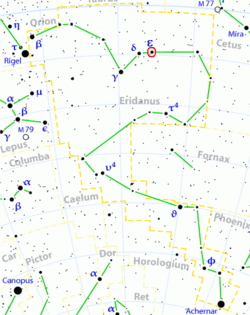Epsilon Eridani
 | ||
| Gözlem verisi Dönem J2000.0 | ||
|---|---|---|
| Takımyıldız | Eridanus | |
| Bahar açısı | (α) | 03s 32d 55.84496sn[1] |
| Yükselim | (δ) | −09° 27′ 29.7312″[1] |
| Görünür parlaklık | (V) | 3.736[2] |
| Sınıflandırma | ||
| Tayfsal sınıf | K2V[3] | |
| U-B Renk ölçeği | +0.571[2] | |
| B-V Renk ölçeği | +0.887[2] | |
| Değişen yıldız türü | BY Dra[4][5] | |
| Gökölçümsel nitelikleri | ||
| Dikey hız | (Rv) | +15.5 ± 0.9[6] km/sn |
| Iraklık açısı | (π) | =311.37 ± 0.1[7] mys |
| Uzaklık | 10.475 ± 0.003 Iy (3.212 ± 0.001 pc) | |
| mutlak parlaklık | (V) | 6.19[8] |
| Özdevinim nitelikleri | ||
| Bahar açısı payı | (μ) | −975.17[1] mys/y |
| Yükselim payı | (μ) | 19.49[1] mys/y |
| Fiziksel özellikler | ||
| Kütle | (m) | 0.82 ± 0.02[9][10] M⊙ |
| Yarıçap | (r) | 0.735 ± 0.005[11] R⊙ |
| Aydınlatma gücü | 0.34[12] L⊙ | |
| Etkin sıcaklık | 5,084 ± 5.9[13] K | |
| Metallik | [Fe/H] | −0.13 ± 0.04[14] |
| Dönüş | 11.2 gün[15] | |
| Dönme hızı | (v sin i) | 2.4 ± 0.5[15] km/sn |
| Tahmini yaş | 400−800[16] y | |
| Katalog belirtmeleri | ||
| Ran, 18 Eridani, BD -09°697, GCTP 742.00, GJ 144, HD 22049, HIP 16537, HR 1084, LHS 1557, SAO 130564, WDS 03330-0928.[4] | ||
Epsilon Eridani (ε Eri, ε Eridani), Eridanus takımyıldızında yer alan bir yıldızdır.
Ayrıca bakınız
Kaynakça
- 1 2 3 4 van Leeuwen, Floor (Kasım 2007), "Validation of the new Hipparcos reduction", Astronomy and Astrophysics 474 (2): 653–664, arXiv:0708.1752v1, Bibcode 2007A&A...474..653V, DOI:10.1051/0004-6361:20078357. Note: see VizieR catalogue I/311.
- 1 2 3 Cousins, A. W. J. (1984), "Standardization of Broadband Photometry of Equatorial Standards", South African Astronomical Observatory Circulars 8 (59), Bibcode 1984SAAOC...8...59C.
- ↑ Gray, R. O. ve diğ. (Temmuz 2006), "Contributions to the Nearby Stars (NStars) Project: spectroscopy of stars earlier than M0 within 40 pc-The Southern Sample", The Astronomical Journal 132 (1): 161–170, arXiv:astro-ph/0603770, Bibcode 2006AJ....132..161G, DOI:10.1086/504637.
- 1 2 "V* eps Eri – variable of BY Dra type", Centre de Données astronomiques de Strasbourg, http://simbad.u-strasbg.fr/simbad/sim-basic?Ident=V*+eps+Eri, erişim tarihi: 15 Nisan 2016.
- ↑ "GCVS query=eps Eri", General Catalog of Variable Stars (Sternberg Astronomical Institute, Moscow, Russia), http://www.sai.msu.su/groups/cluster/gcvs/cgi-bin/search.cgi?search=eps+Eri, erişim tarihi: 15 Nisan 2016.
- ↑ Batten, Alan Henry; Heard, John Frederick, D. S. (20–24 Haziran 1966), "The revision of the general catalogue of radial velocities", Determination of Radial Velocities and their Applications, Proceedings from IAU Symposium no. 30 (International Astronomical Union) 30: ss. 57, Bibcode 1967IAUS...30...57E.
- ↑ Benedict, G. Fritz ve diğ. (Kasım 2006), "The extrasolar planet e Eridani b – orbit and mass", The Astronomical Journal 132 (5): 2206–2218, arXiv:astro-ph/0610247, Bibcode 2006AJ....132.2206B, DOI:10.1086/508323.
- ↑ Staff (8 Haziran 2007), The one hundred nearest star systems, Research Consortium On Nearby Stars, http://www.astro.gsu.edu/RECONS/TOP100.posted.htm, erişim tarihi: 15 Nisan 2016
- ↑ Gonzalez, G.; Carlson, M. K.; Tobin, R. W. (Nisan 2010), "Parent stars of extrasolar planets – X. Lithium abundances and v sini revisited", Monthly Notices of the Royal Astronomical Society 403 (3): 1368–1380, arXiv:0912.1621, Bibcode 2010MNRAS.403.1368G, DOI:10.1111/j.1365-2966.2009.16195.x. See table 3.
- ↑ Baines, Ellyn K.; Armstrong, J. Thomas (2011), "Confirming Fundamental Parameters of the Exoplanet Host Star epsilon Eridani Using the Navy Optical Interferometer", The Astrophysical Journal 748: 72, arXiv:1112.0447, Bibcode 2012ApJ...748...72B, DOI:10.1088/0004-637X/748/1/72.
- ↑ Demory, B.-O. ve diğ. (Ekim 2009), "Mass-radius relation of low and very low-mass stars revisited with the VLTI", Astronomy and Astrophysics 505 (1): 205–215, arXiv:0906.0602, Bibcode 2009A&A...505..205D, DOI:10.1051/0004-6361/200911976. See Table B.1
- ↑ Saumon, D. ve diğ. (Nisan 1996), "A theory of extrasolar giant planets", The Astrophysical Journal 460: 993, arXiv:astro-ph/9510046, Bibcode 1996ApJ...460..993S, DOI:10.1086/177027, http://articles.adsabs.harvard.edu/full/1996ApJ...460..993S. See Table A1, p. 21.
- ↑ Kovtyukh, V. V. ve diğ. (Aralık 2003), "High precision effective temperatures for 181 F-K dwarfs from line-depth ratios", Astronomy and Astrophysics 411 (3): 559–564, arXiv:astro-ph/0308429, Bibcode 2003A&A...411..559K, DOI:10.1051/0004-6361:20031378.
- ↑ Santos, N. C.; Israelian, G.; Mayor, M. (Mart 2004), "Spectroscopic [Fe/H] for 98 extra-solar planet-host stars: Exploring the probability of planet formation", Astronomy and Astrophysics 415 (3): 1153–1166, arXiv:astro-ph/0311541, Bibcode 2004A&A...415.1153S, DOI:10.1051/0004-6361:20034469.—the percentage of iron is given by , or 74%
- 1 2 Fröhlich, H.-E. (Aralık 2007), "The differential rotation of Epsilon Eri from MOST data", Astronomische Nachrichten 328 (10): 1037–1039, arXiv:0711.0806, Bibcode 2007AN....328.1037F, DOI:10.1002/asna.200710876.
- ↑ Janson, Markus ve diğ. (Şubat 2015), "High-contrast imaging with Spitzer: deep observations of Vega, Fomalhaut, and ε Eridani", Astronomy & Astrophysics 574: 10, arXiv:1412.4816, Bibcode 2015A&A...574A.120J, DOI:10.1051/0004-6361/201424944, A120.
Dış bağlantılar
- Marcy, G. ve diğ. (12 Şubat 2002), A Planet Around Epsilon Eridani?, Exoplanets.org, http://exoplanets.org/esp/epseri/epseri.shtml, erişim tarihi: 15 Nisan 2016.
- Staff (8 Temmuz 1998), "Astronomers discover a nearby star system just like our own Solar System", Joint Astronomy Centre (The University of Hawaii), http://outreach.jach.hawaii.edu/pressroom/1998_epseri/, erişim tarihi: 15 Nisan 2016.
- Anonymous, "Epsilon Eridani", SolStation (The Sol Company), http://www.solstation.com/stars/eps-erid.htm, erişim tarihi: 2008-11-28.
- Tirion, Wil (2001), "Sky Map: Epsilon Eridani", Planet Quest (Cambridge, U.K.: Cambridge University Press), http://planetquest1.jpl.nasa.gov/atlas/atlas_skymap.cfm?Planet=109&Zoom=1, erişim tarihi: 15 Nisan 2016.
| |||||||||||||||||||||||||||||||||
Koordinat:![]() 03s 32d 55,8442sn; -09º 27' 29,744″
03s 32d 55,8442sn; -09º 27' 29,744″
This article is issued from Vikipedi - version of the 9/14/2016. The text is available under the Creative Commons Attribution/Share Alike but additional terms may apply for the media files.